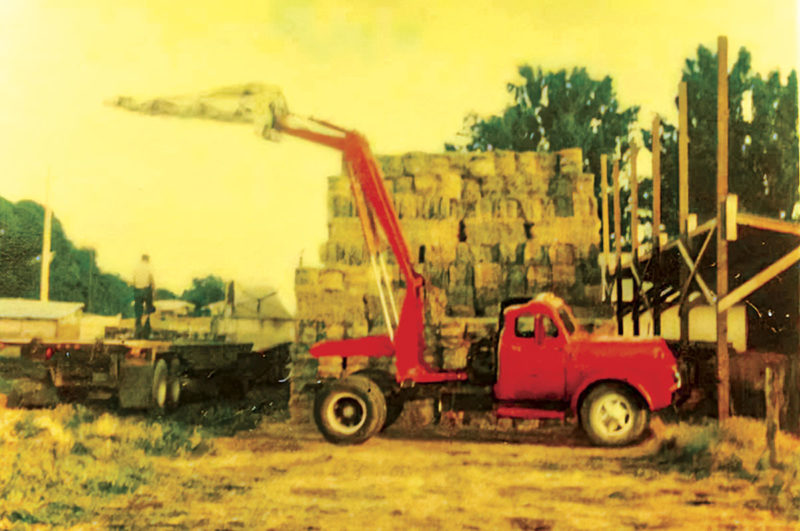A bystander in the shop I had use of asked that question of my brother Lyle as we were assembling what we called the “Doodle Bug.” Loading and unloading hay one, two or three tie bales at a time was taking a toll on the body.
Watching the mechanization other hay haulers used gave me ideas as to what would work in my operation. I ended up combining a 1951 Dodge truck chassis and a high-lift loader, originally made to fit on a large farm tractor. Part of the deal for the used loader was a bale fork.
The main types of small-bale loader attachments, or forks, were the free-pivoting kind, which was widely used in eastern Idaho. This had a fixed heel, which was used to push against the pad of hay to be picked up, and teeth that rotated into the bales to pull the hay back against the heel. The fork swung forward and back on a pivot mounted so that, when loaded, the fork and its load of bales hung kind of balanced.
This was lightning fast, as the only controls were the up-down and the tooth-rotate levers. How fast? I arrived by appointment in the Mud Lake/Terreton area of eastern Idaho for a load of hay. I had been forgotten. Grandma was the only one home. When she realized my predicament, she said, “Well, I can certainly run the loader tractor. If you know which stack I can set the bales on the truck for you.”
And that she did. It was completely dark as we finished the load, and with sunset, the temperature dropped to near zero. We were less than an hour loading, with most of the bales placed near their final spot on the truck and trailer. I had shed clothes down to shirtsleeves, and “Grandma” was putting hay on the truck so fast that I was wringing wet with sweat when we finished. From her heated tractor cab, yes, she certainly could load hay.
My bale fork didn’t swing free but tilted hydraulically. My fork had four rows of teeth that pivoted in pairs, the near pair pulling toward each other and the far pair also toward each other.
An advantage of this, versus all four rows pulling toward the heel, was that I could pick up a single bale anywhere on the fork instead of back against the heel. The main plus was for unloading. We mostly loaded with a bale conveyor and hand-stacked the load. The tie layers had the rail, or front-to-rear bales, at the perimeter of the load, with some air space inside. (Three-tie hay didn’t matter because the bales were wider and didn’t leave a space on the tie layer.)
My fork would pick up the tie layer as stacked and place it to be a tie layer in the unloaded stack. The times I had someone with the other configuration of bale fork unload me, he had to push the tie layer over with the heel of his fork so there was no space between, otherwise his fork wouldn’t grab all the bales.
When asked about plans, Lyle said, “Yes, there are plans.” When asked where they were, he said, “In Brad’s head.”
We ended up using a six-cylinder engine and transmission from a Ford pickup. The biggest challenge was to get live hydraulic power. The Ford’s crankshaft pulley had enough V-belt grooves, so one V-belt ran the power steering, fan, water pump and alternator. The other two grooves ran a hydraulic pump.
After the first unload, the rear-facing second set of operating controls was modified from cable-actuated to hydraulic, which came from a wrecking-yard pickup.
We could drive it to the unload site, unload, then either drive or haul it home.
The similar units in eastern Idaho would operate mainly to load – usually a mile or less from home. The most common was a 2-ton Chevy truck with the whole cab turned around to face the rear, also mounting a farm-style loader over the drive axle of the donor truck. The most common power was a Chevy V-8 and an automatic transmission.
Times change. Today, most hay is in big bales, loaded with a Telehandler or front-end loader equipped with forks to pierce and lift the bales. Most dairies and feedlots are set up to unload trucks the same way.
Oregon Roadrunner-style squeeze loaders are all over the West. They’re a mating between a hay squeeze clamp, a heavy fork-lift mast and the running gear of a heavy diesel truck.
All of the above started as an idea in someone’s head. And like my Doodle Bug, they rolled out of the shop ready for work. And they also were altered as needed to be faster, more capable and reliable and easier to operate.












